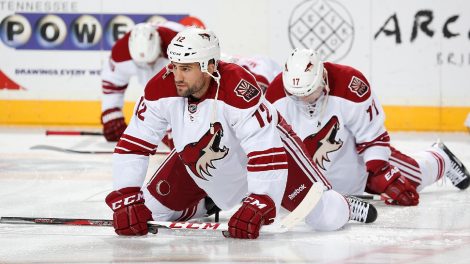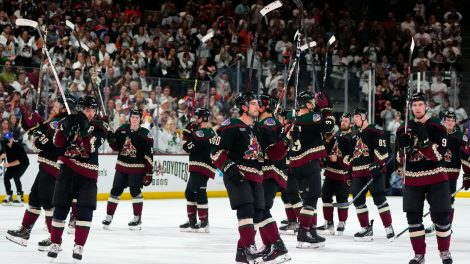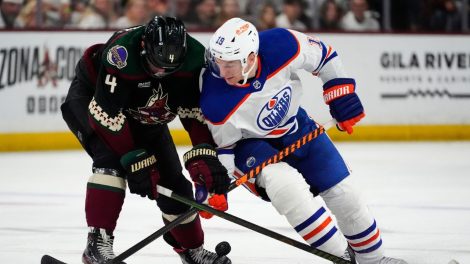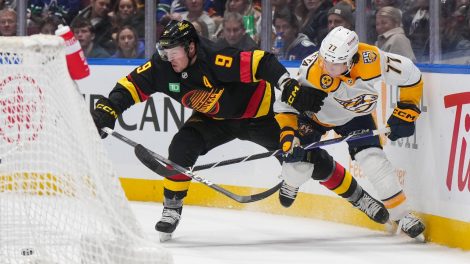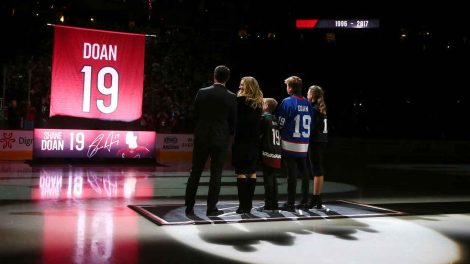Vancouver Canucks centre Bonino is essentially the antithesis of the player he was traded for at the 2014 NHL Entry Draft, former Selke Trophy winner Ryan Kesler.
Kesler plays hockey like a human fastball, relying on raw speed and an uninhibited physical style to control play.
Bonino is smaller in stature, slower of foot and isn’t likely to generate Selke buzz this season, or any other. Stepping into the Canucks’ second-line forward spot that Kesler warmed for half a decade, Bonino has found success by expertly painting the edges of the plate – whether it’s compensating for his lack of size with high hockey IQ, or for his average speed with excellent footwork.
On pace to finish the season with fewer points than he managed a year ago, Bonino has still exceeded all reasonable expectations in his first year with the team, mostly as a result of his improved 5-on-5 game.
Bonino is producing more, he’s doing more to help control play, and he’s doing it all while handling a much more difficult role than he did a season ago with the Anaheim Ducks.
The 26-year-old American has started the lowest ratio of shifts in the offensive zone compared to starts in the defensive end among regular Canucks forwards and he’s also faced the toughest competition, according to the Corsi-relative quality of competition metric found at behindthenet.ca.
That he’s been tasked with battling significantly tougher competition this year is corroborated by the head-to-head ice-time. Among the 10 forwards Bonino most frequently matched up against at 5-on-5 last season, you’ll find the likes of David Moss, Ryan Kesler, Brad Richardson, Anze Kopitar and James Sheppard. This year you’ll find names like Kopitar, Joe Pavelski, Marian Gaborik, Joe Thornton and Ryan Getzlaf – a testament to his being used as an occasional matchup centre by Canucks coaches.
As a matchup centre, Bonino has had a borderline astonishing level of success. He’s in the black by both raw and team-relative shot attempt differential (something you can’t say about Kesler), and five of the six forwards with whom he’s logged at least 100 even-strength minutes have a better Corsi For percentage with Bonino than without him.
There’s also his notable level of success against the top pivots in the Pacific. Bonino has gone head-to-head with the top-three centremen in California (Thornton, Kopitar, Getzlaf) for nearly 70 combined 5-on-5 minutes this season. In those 70 minutes, the Canucks haven’t surrendered a single goal against.
“You always want to be counted on to play important minutes,” Bonino told Sportsnet.ca during a telephone conversation late last week. “It has felt good.
“I have more even-strength points than I did last year playing against tougher competition. You’re always improving, and that’s something I’m happy about: that my game in that aspect has improved. It’s fun, it’s fun to matchup against some of the best players and best lines and try to do a good job on them.”
That Bonino is comfortable dissecting his production in this manner – separating his inflated power play totals of a year ago from his offensive output at 5-on-5 – speaks to his level of astuteness. His cerebral approach captured the attention of one of the league’s most professorial snipers even before they were teammates and linemates in Vancouver.
“He’s a great player and I know that from when he was in Anaheim and I was in Phoenix,” Canucks forward Radim Vrbata said of Bonino.
“When the change was made, with the way he plays, it suits the way I play,” Vrbata continued, addressing the chemistry he’s found on Bonino’s wing of late. “It was just a matter of finding (that familiarity).”
Bonino’s increasingly well-rounded defensive game is also earning him some praise among NHL pro scouts.
“When I watch him play I think he’s a smart two-way player with decent skills. (He’s) probably never going to be a high-end offensive guy, so he’s still kind of finding his niche and what he’ll be long-term – more of a two-way guy, maybe with a little bit more defensive value,” opined a rival NHL pro scout.
“He can play against top lines and still has the hockey sense to create offense, which is what you need from a guy playing those types of minutes. You need a player who can punish the opposition’s mistakes.”
There was a stretch of the season, though, when Bonino’s ability to punish the opposition’s mistakes abandoned him. Bonino might be outpacing his 5-on-5 production of a year ago, but a hefty portion of that came in a short two-month burst at the start of the year. In 30 games between the end of November and the beginning of March, Bonino managed just four goals and six total points.
“It hasn’t been super frustrating,” Bonino said of his extended mid-season cold streak. “It’s a case of if I wasn’t getting chances and wasn’t creating then I think it would be a little more frustrating, but I could look at every game and see four or five scoring chances that just weren’t going in.
“Obviously with the hot start that I had it might have (misrepresented) how it usually is, but it’s nice to start like that. Hopefully I can get hot again a little bit here.”
Both hot and cold streaks are inevitable in hockey, but they don’t last. Nor do the physical abilities of an NHL player. But Hockey IQ? That’s forever.
Stats in this piece compiled from behindthenet.ca, NHL.com and hockeyanalysis.com.




